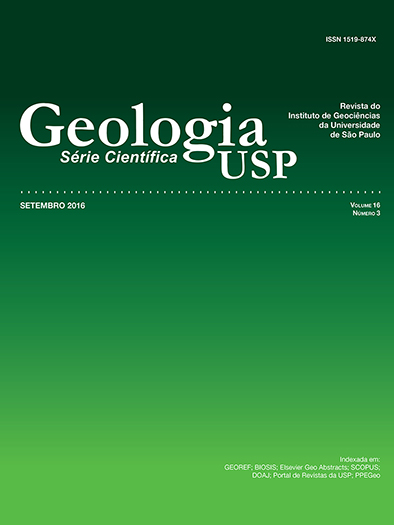Geoquímica do magmatismo Ediacarano Serra do Caramuru, NE da Província Borborema, RN, Brasil
DOI:
https://doi.org/10.11606/issn.2316-9095.v16i3p117-142Palavras-chave:
Magmatismo Serra do Caramuru, Domínio Rio Piranhas-Seridó, Plutonismo, Petrologia, Geoquímica.Resumo
Os stocks Serra do Caramuru e Tapuio (magmatismo Serra do Caramuru), localizados no extremo NE do Domínio Rio Piranhas-Seridó (RN), são representantes do plutonismo ediacarano a cambriano da Província Borborema. Análises químicas de rocha total (elementos maiores e traço, incluindo elementos terras raras) em amostras provenientes principalmente do stock Serra do Caramuru permitiram efetuar a caracterização geoquímica deste magmatismo. Foram identificadas as fácies diorítica, granítica porfirítica, granítica equigranular I e granítica equigranular II, além de diques e sheets graníticos. A fácies diorítica é leucocrática a melanocrática, rica em biotita e hornblenda. As fácies graníticas são hololeucocráticas a leucocráticas, com biotita e eventualmente hornblenda. A variação no conteúdo de óxidos e elementos traço sugere o fracionamento de zircão, apatita, titanita, clinopiroxênio (em dioritos), biotita, hornblenda, allanita, plagioclásio, microclina e granada (em diques tardios). O comportamento de Zr, La e Yb indica que dioritos não constituem o magma parental dos granitos. Por outro lado, as fácies graníticas parecem ser cogenéticas, apresentando trends de diferenciação e espectros de elementos terras raras (ETR) análogos [12,3≤(La/Yb)N≤190,8; Eu/Eu*=0,30-0,68]. O padrão de ETR de diques e sheets graníticos [6,96≤(La/Yb)N≤277,84; Eu/Eu*=0,18-0,58] sugere não cogeneticidade ao magmatismo Serra do Caramuru. A fácies diorítica é metaluminosa, shoshonítica, enquanto os granitos são metaluminosos a ligeiramente peraluminosos, cálcio-alcalinos de alto potássio. Diagramas envolvendo óxidos e elementos traço corroboram um ambiente pós-colisional. Os dados aportados permitem correlacionar o magmatismo Serra do Caramuru ao grupo de granitoides pós-colisionais, cálcio-alcalinos de alto potássio com eventuais associações shoshoníticas, do Domínio Rio Piranhas-Seridó.
Downloads
Publicado
Edição
Seção
Licença
Autores que publicam nesta revista concordam com os seguintes termos:
- Autores mantém os direitos autorais e concedem à revista Geologia USP. Série Científica, o direito de primeira publicação, com o trabalho sob a licença Creative Commons BY-NC-SA (resumo da Licença: https://creativecommons.org/licenses/by-nc-sa/4.0 | texto completo da licença: https://creativecommons.org/licenses/by-nc-sa/4.0/legalcode) que permite o compartilhamento do trabalho de forma não comercial e conferindo os devidos créditos autorais da primeira publicação nesta revista.
- Autores têm autorização para assumir contratos adicionais separadamente, para distribuição não-exclusiva da versão do trabalho publicada nesta revista (publicar em repositório institucional ou como capítulo de livro), conferindo os devidos créditos autorais da primeira publicação nesta revista.
- Autores têm permissão e são estimulados a publicar e distribuir seu trabalho online (em repositórios institucionais ou na sua página pessoal) a qualquer ponto antes ou durante o processo editorial, uma vez que isso pode gerar alterações produtivas, bem como aumentar o impacto e a citação do trabalho publicado (Veja O efeito do Acesso Aberto e downloads no impacto das citações).















